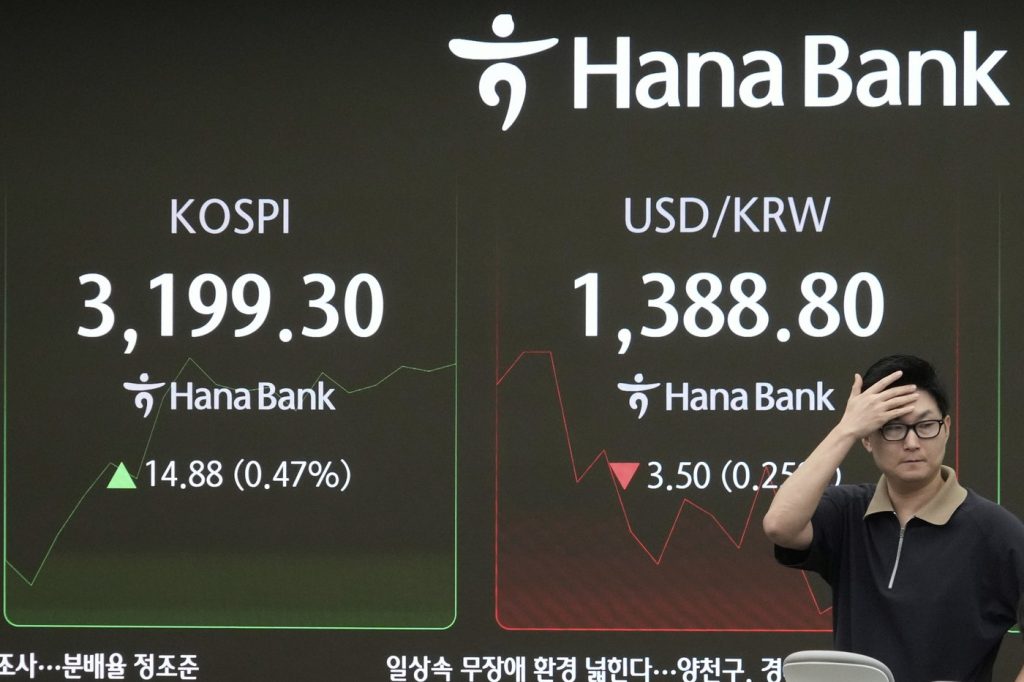MANILA, Philippines (AP) – Shares in Asia experienced a generally positive trend on Thursday following a technology stock rally that helped stabilize Wall Street and a significant drop in the U.S. dollar, making Asian assets more appealing to investors. U.S. futures exhibited a mixed response, while oil prices showed a decline.
Japan’s Nikkei 225 index rose by 1.2% to close at 42,437.37, and Australia’s S&P/ASX 200 increased by 0.6% to 8,791.50. South Korea’s Kospi also saw a modest uptick of 0.2% to 3,192.22. Taiwan's stock market gained 0.7%, and India's BSE Sensex climbed 0.6%. In contrast, Chinese markets did not follow this upward trend; Hong Kong's Hang Seng index dropped by 1.1% to 25,006.22, and the Shanghai Composite index fell nearly 2% to 3,738.32 due to concerns that regulators might intervene amid a surge in stock prices and liquidity issues.
Wall Street had steadied earlier, buoyed by a notable rally in technology stocks, including Alphabet. Relief also came from easing pressures in the bond market. Recent disappointing job market data increased expectations that the Federal Reserve would be inclined to cut interest rates, pushing forward market dynamics aimed at supporting economic growth.
The S&P 500 index rose by 0.5%, breaking a two-day losing streak following its recent all-time high. The Dow Jones Industrial Average saw a slight decrease of 24 points, or 0.1%, while the Nasdaq composite surged by 1%. Google’s parent company, Alphabet, was a significant contributor to the market's positive movement, witnessing a 9.1% increase after reports indicating that it sidestepped some of the worst-case outcomes in its antitrust case.
Wednesday’s market conditions were supported by a calming bond market atmosphere. Previously, global yields had climbed due to investor fears regarding governments' capabilities to manage their growing debt levels. Concerns surrounding potential inflation due to President Trump's influence on the Federal Reserve to lower short-term interest rates also played a role in these dynamics.
As bond yields increase, investors typically seek higher returns from bonds rather than riskier equities. However, following the recent disappointing job market report, which indicated that U.S. employers were advertising 7.2 million job openings at the end of July—less than economists anticipated—Treasury yields saw a retreat. For instance, the yield on the 10-year Treasury fell from 4.28% to 4.22%.
The weakened outlook on the job market suggests that the Federal Reserve might consider cutting its main interest rate for the first time in 2023 in its upcoming meeting. This anticipation among traders is heightened by an imminent report on U.S. hiring for August.
While lower interest rates may stimulate market activity and boost the overall economy, they can also pose an inflation threat, particularly with ongoing tariffs potentially increasing import prices. Stephen Innes of SPI Asset Management noted that “the dollar, naturally, buckled under the weight of weaker jobs and lower rates,” which enhances the attractiveness of Asian assets in currency-adjusted terms.
On the commodities front, U.S. benchmark crude oil prices fell by 42 cents to $63.55 per barrel, while Brent crude, the international benchmark, decreased by 35 cents to $67.25 per barrel. In the currency markets, the U.S. dollar rose to 148.24 Japanese yen from 148.05 yen, whereas the euro dipped to $1.1653 from $1.1667.
The broader implications of these market movements reflect a complex interplay between jobs data, bond yields, and currency fluctuations, all of which significantly impact investor confidence and market performance in Asia and beyond.










